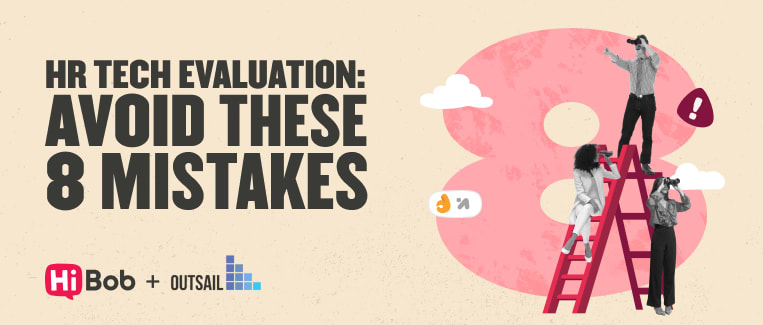This article was written by Brett Ungashick, founder of OutSail and a recognized expert in HR technology.
When I started my career in software sales, I thought I understood software buyers. However, building a business supporting buyers revealed how little I really knew.
Early on, I remember calling a prospective client who got incredibly upset with me for interrupting her busy day. Surprisingly, after calmly staying on the line and genuinely discussing her recruitment challenges, she realized our solution directly addressed her most pressing needs. Just a few weeks later, she became a client.
This encounter was eye-opening: it revealed that her frustration with the constant barrage of sales calls was more intense than her actual recruitment challenges. It was my first clear view of the pervasive “vendor fatigue” problem buyers experience.
Behind the scenes, buyers juggle multiple vendors, constantly have to create tools and resources from scratch, and remain guarded and cautious based on past experiences with overpromising sales teams.
Having guided hundreds of HR tech evaluations, I’ve identified recurring pitfalls. Here are eight common mistakes to avoid to ensure your next HR tech purchase delivers true strategic value:
1. Prioritizing features over outcomes
Many organizations begin their HR tech evaluations with an extensive features checklist. While this thorough approach has merit, it frequently misses the broader point.
Maybe 15 years ago, when there were fewer and more limited systems on the market, differentiating platforms by features was meaningful. But today, vendors know they get more opportunities if they simply check more boxes, creating widespread feature parity.
Frequently, I see buyers circulate extensive requirement lists to several vendors, only to receive responses overwhelmingly filled with “yes, we offer this.” This practice becomes ineffective and rarely helps narrow down the right solution.
The deeper issue with this features-centric approach is that it causes teams to lose sight of the bigger picture. Buyers get so caught up in small details and specific features that they can overlook critical strategic objectives.
I’ve witnessed teams stall their entire evaluation over the absence of a single minor feature. However, when investing in an enterprise system like HRIS, the goal isn’t merely acquiring a set of functionalities. Instead, the objective should be achieving broader business outcomes such as increased operational efficiency, deeper analytical insights, seamless integration with existing business systems, and scalable agility.
At OutSail, we advise treating features as a quick check-the-box exercise—helpful but secondary. Quickly confirm basic functionality, then swiftly transition the conversation to focus on your key strategic outcomes. This helps ensure you make informed, impactful decisions aligned with your broader business vision.
2. Shortlisting too many vendors
Another challenge I often see in the software buying process is that buyers shortlist far too many vendors. Shortlisting is understandably tough because there’s an inherent lack of reliable, easily accessible information about vendors (a problem we’re actively solving with OutSail’s marketplace).
Vendor websites are typically intentionally vague—you’ll rarely find actual pricing data, clear information about the size of companies they specialize in serving, or true industry specialization.
Often, you’ll see statements like, “We serve these 18 key industries,” leaving you with more questions than answers. Vendor websites are primarily designed to funnel you toward requesting a demo rather than offering genuine clarity about suitability.
When vendor websites lack adequate clarity, buyers turn to peer recommendations, network connections, software review sites, or trusted advisors.
However, these recommendations carry significant limitations: they often lack crucial context (a great fit for one business might be irrelevant to another) and are consistently inconsistent (one reviewer praises a vendor while the next strongly criticizes the same one).
This uncertainty inevitably leads buyers to default to casting too wide a net. They hesitate to exclude vendors because they fear backlash from internal stakeholders if questioned later in the evaluation.
Consequently, buyers set up numerous vendor meetings—five, six, or even eight—each meeting adding exponential complexity rather than linear work. Calendars become packed with seemingly endless meetings, and inboxes overflow with well-meaning but urgent sales follow-ups.
Buyers who endure these extensive demo sessions frequently find themselves overwhelmed, struggling to remember the differences between vendors. This confusion often prompts additional meetings, further delaying the evaluation. To avoid this frustrating loop, aim to shortlist no more than three or four highly targeted vendors whose offerings align closely with your strategic goals.
3. Attending demos unprepared
Even if buyers could magically summon the three best vendors to their final shortlist, mistakes frequently occur during the evaluation and demo process due to inadequate preparation.
A common approach is to simply “show up and see what the vendors present,” but this passive strategy rarely yields effective outcomes. Often, this approach stems from insufficient clarity on key requirements or focusing excessively on granular details that all vendors can easily fulfill, providing no meaningful differentiation.
A more effective method is to build a structured evaluation scorecard aligned with high-level business outcomes. Develop tailored questions and specific demo scenarios categorized by each major outcome you’re seeking. Without this clear roadmap, you risk falling into several common traps during the demo process:
- The “shiny object” fallacy: Becoming overly impressed by innovative yet peripheral features that don’t significantly address your core needs.
- The “lovely salesperson” trap: Making decisions influenced primarily by the salesperson’s charisma or style. Remember, this salesperson is likely to transition out of the process shortly after the sale.
- The “last pitch” trap: Salespeople strategically schedule their presentations last, knowing buyers often disproportionately favor their most recent interaction.
Structured evaluations prevent these common errors, ensuring your vendor choice genuinely aligns with strategic business outcomes rather than temporary impressions.
4. Not bringing internal stakeholders along
One of the most frustrating setbacks during an HR tech evaluation is neglecting to involve critical internal stakeholders early in the process.
We recommend proactively asking stakeholders, including finance, IT, HR, and operational leaders, which vendors they favor and would want to see shortlisted. It’s frustrating when a team does extensive preliminary work, only for a senior stakeholder like the CFO to question, “Why haven’t we considered Vendor X?” This oversight can halt the evaluation, forcing teams to pause and catch new vendors up to speed.
Additionally, gathering stakeholder feedback on their specific needs and priorities upfront helps maintain forward momentum and prevents late-stage derailments. Engage stakeholders early and regularly to capture their requirements, ensuring alignment across your organization from day one.
Finally, initiate budgeting conversations early—even if precise proposals are unavailable. Understand the financial scope, flexibility, and strategic expectations from leadership. Asking key budget-related questions upfront—such as available resources and the financial appetite for strategic shifts—prevents surprises and enables smoother, quicker decision-making.
5. Overvaluing minor pricing differences
Enterprise software pricing is far more flexible than most buyers realize. Many buyers mistakenly dismiss their preferred vendor due to minor price differences.
Pricing flexibility doesn’t mean vendors will cut their prices in half, but if there’s genuine alignment between a vendor’s solution and your business needs, vendors often demonstrate significant flexibility to reach a mutually beneficial agreement.
Successful pricing negotiations typically aren’t driven by aggressive demands but rather through collaborative discussions built on mutual trust. Clearly communicate to your sales representative that their solution is your top choice, outlining specific conditions that would seal the agreement, such as budget constraints, desired contract terms, or timing for contract execution.
Remember, your sales rep isn’t your adversary—they’re your internal advocate. Most reps have limited direct authority to discount but can effectively advocate for you internally if they trust your commitment.
Providing concrete assurances, like a clear sign-by date, empowers your rep to justify special concessions, including discounts, deferred payments, or additional bundled services. This collaborative approach ensures pricing aligns closely with your expectations, benefiting both your organization and the vendor through a strong, long-term partnership.
6. Underestimating implementation requirements
Choosing the right HR software is only half the battle. A successful implementation is critical to realizing the full value of your technology investment, yet it’s commonly underestimated.
Implementation often requires a significant internal resource commitment—typically 40-60 hours monthly—and specialized skillsets across multiple teams. Without adequate planning, staffing, and budgeting for this phase, implementations can quickly stall or suffer from rushed, incomplete processes.
Allocate appropriate resources upfront, clearly define team roles, and consider leveraging external implementation specialists if your internal bandwidth is limited.
7. Lack of clear implementation goals
Many buyers assume vendors will guide the implementation completely, but vendors typically present multiple configuration options and rely on you to specify your needs. Without documented existing processes or clearly defined future states, decisions during implementation become cumbersome, leading to delays and frustration.
Clearly articulate your process goals and expectations upfront. Map current workflows and desired outcomes in advance, providing explicit guidelines that enable vendors to configure your system effectively from the outset.
Recommended For Further Reading
8. Neglecting data preparation
The phrase “garbage in, garbage out” strongly applies to HR tech implementations. Dirty, inconsistent data can derail even the most sophisticated software solution.
Data cleaning and preparation, though tedious, are fundamental. Thorough data audits and corrections, as well as clear data governance protocols, ensure a smooth transition and reliable system performance from day one. Prioritize data hygiene as a foundational component of your HR tech strategy to maximize system accuracy and usability.
Mastering HR tech evaluations: The path to success
Evaluating HR technology effectively is challenging but achievable. Focusing on strategic outcomes rather than checklists, managing vendor selections, preparing for demos, understanding implementation demands and objectives, and rigorously managing data quality are critical steps that dramatically improve evaluation outcomes.

From Brett Ungashick
Brett Ungashick is the friendly face behind OutSail, a company he founded in 2018 after selling HR software at LinkedIn. Brett has simplified HR tech selection for over 1,000 companies worldwide. When he's not demystifying HR tech, you'll find him golfing or skiing Colorado's slopes.

